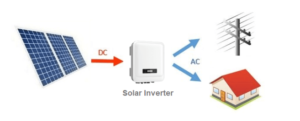
First, let’s clarify the role of an inverter. Solar panels generate DC power, while household appliances operate on AC power, as supplied by the electricity grid. The primary role of a solar inverter is to convert DC solar power to AC power. The solar inverter is one of the most important parts of a solar system and is often overlooked by those looking to buy solar energy. This review highlights the best inverters from the world’s leading manufacturers to ensure your solar system operates trouble-free for many years.

Types of solar inverters
Choosing the best type of inverter for a solar energy system depends on various factors, including system size, installation location, budget, and specific requirements. Here’s a breakdown of each type of inverter and considerations for selecting the most suitable option:
1.String Solar Inverters
String Solar inverts are the most common type of inverter available and are the most affordable option for people looking for a basic solar system without battery storage. These inverters are available in a huge range of sizes and brands and are generally very reliable if installed correctly in an appropriate location. In a standard string inverter system, three to fourteen or more solar panels are connected in series to form strings of solar panels. The DC electricity from the strings is brought to the solar inverter via a high-voltage DC cable. The inverter then converts the DC power to AC power, which can be used in the home or fed into the electricity grid.
Advantages:
-
ost-effective for small to medium-sized systems.
-
Simplified installation and maintenance due to centralised placement.
-
Best for installations with unshaded panels and consistent sun exposure across all panels.
2. Microinverters
Microinverters can offer several benefits over string solar inverters, especially for those with complex rooftops and severe shading issues from trees of roof-mounted obstacles. In a microinverter system, each panel has a small microinverter attached to the rear side of the panel. Your home appliances or the grid receive AC after the panel on the roof converts DC and is then fed to the electrical switchboard.. Each panel works independently with the help of microinverters, making them ideal for complex roofs and locations with shading from trees or rooftop obstacles.
Advantages
-
Optimized energy production, especially in installations with shading or panel-level differences in performance.
-
Greater system design flexibility as panels can be oriented in different directions or have varying tilt angles.
-
The system can be upgraded with new panels of a different type or voltage at any time to increase solar capacity and boost power.
-
3. Hybrid Inverters
Home battery storage and backup power can be provided by Hybrid Inverters, acting as solar inverters. They function the same as solar inverters and generally look very similar, with inputs for solar panel strings. However, they also feature battery connections and controls, plus most hybrid inverters provide emergency or backup AC power. See more information in the hybrid inverter section below.
Advantages:
Provides greater energy independence through battery storage integration.
Enables self-consumption optimisation by storing excess solar energy for use during periods of low solar generation or high grid demand.
Provides backup power during grid outages and can operate in off-grid mode.
Best inverter for your needs
When choosing between string, micro, or hybrid inverters, it’s essential to understand your specific needs, budget constraints, and system requirements. Consider factors such as shading, panel orientation, energy storage requirements, and backup power needs to determine the best fit for your household. Consulting with a qualified solar installer or system designer can also provide valuable insights and recommendations based on your individual circumstances.
Regular shading of solar panels can be a big problem, resulting in panel failure. Advanced string inverter systems, each with a small power optimizer attached to the back, fortunately exist for solar panels. Much like microinverters,power can monitor and control each panel individually and ensure every panel is operating at maximum efficiency under all conditions.
https://solarmax.pk/shop/inverters.html
https://goforsolar.pk/product-category/solar-inverters/
Leave a Reply